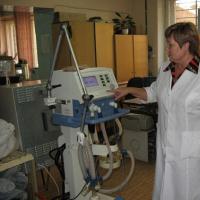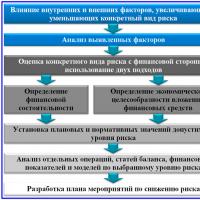Training of employees on labor protection in the organization. Training of employees on labor protection within the organization Methodological materials on labor protection in the organization
Training employees on labor protection is an important event aimed at ensuring the safety of the work process at the enterprise. This article will discuss how to organize staff training and what you need to know for this.
Conducting training and instructing workers on labor protection (OHS)
According to the law, every employee of the organization must be provided with such labor conditions, which meet all the requirements for his safety, while being a guarantee that the employee’s work activities are protected (Article 219 of the Labor Code of the Russian Federation). In this regard, the state puts forward a number of occupational safety requirements, which the employer must strictly observe, and the conditions for their implementation are enshrined in employment contracts with each employee (part 1.2 of article 220 of the Labor Code of the Russian Federation).
Art. 225 of the Labor Code of the Russian Federation establishes the fundamental rules for training in the field of occupational safety at an enterprise:
- All persons working in the organization must be trained in occupational safety and undergo testing of relevant knowledge. It's about both about managers (as well as employers - individual entrepreneurs) and about ordinary employees.
- For citizens hired for the first time (including by way of transfer), the employer's representative is required to provide occupational safety training. In addition, it is necessary to provide training on safe methods of implementation. labor function, as well as methods of providing first aid to injured employees medical care.
- For persons taking up jobs where conditions are dangerous or harmful, the employer must provide training followed by internships and arrange for examinations. At the same time, it is necessary to train employees and test their knowledge regularly, throughout the entire period of their work.
- For the purpose of qualified training of specialists in the field of occupational safety, organizations receive support from the state. It is also intended to provide assistance in these matters to institutions providing general education services.
OT training
On January 13, 2003, by joint resolution of the Ministry of Labor of the Russian Federation and the Ministry of Education of the Russian Federation No. 1/29, the Procedure for training in occupational safety and testing the knowledge of occupational safety of employees of organizations was approved (hereinafter referred to as the Procedure). In accordance with this document, the employer is responsible for the timely preparation and conduct of such an event (clause 1.7 of the Procedure).
Thus, clause 2.1 of the Procedure imposes on a person (a specialized occupational safety specialist or an employee authorized by order of the manager) the responsibility for instructing employees who have been rehired or received a position through transfer.
Instruction includes the employee studying production factors that may be dangerous or harmful, becoming familiar with occupational safety requirements, instructions and other documents, as well as taking measures that are safe when carrying out work (part 3, clause 2.1.3 of the Procedure).
The briefing ends:
- oral verification by the instructing person of the acquired knowledge by the employee (part 4, clause 2.1.3 of the Procedure);
- registration of the event in special magazine with the signatures of the persons participating in this event and its date (part 5, clause 2.1.3 of the Procedure).
An occupational safety specialist or an employee who is assigned this responsibility by order of the director of the organization (clause 2.1.2 of the Procedure) is authorized to conduct instructions. This person must be the work manager, be trained in the basics of occupational safety and tested regarding the knowledge acquired. This requirement does not apply to persons conducting induction training (clause 2.1.3 of the Procedure).
Types of instruction
- Introductory. It is carried out until the citizen begins his work, according to a program the content of which is based on the specifics and characteristics of the enterprise’s activities (clause 2.1.2 of the Procedure);
- Primary. Organized with the participation of all employees newly employed in the organization, as well as transferred from another enterprise or who received new position. The employer has the right to approve a list of positions or professions of employees of the organization who are exempt from the need to receive this instruction (clause 2.1.4 of the Procedure);
- Repeated. Carried out in relation to employees and according to the initial briefing program, at least once every six months (clause 2.1.5 of the Procedure);
- Unscheduled. Carried out in the following cases (clause 2.1.6 of the Procedure):
- the entry into force of new legislative norms, instructions in the field of occupational safety or their changes;
- changes in technological processes, replacement or improvement of equipment, working tools and other conditions that may affect the safety of the labor process;
- serious violations of occupational safety requirements committed by employees, which could lead to serious consequences;
- issuing orders for training by regulatory or supervisory authorities;
- interruption of the work process for more than 2 months, and in hazardous or hazardous industries - more than 1 month;
- making a decision by the head of the organization or a person authorized to do so.
- Target. Organized at (clause 2.1.7 of the Procedure):
- performing work of a one-time nature;
- eliminating the consequences of industrial accidents and natural disasters;
- carrying out work for which special documents must be drawn up (permits, permits, work orders);
- holding events at the enterprise with a large number of participants.
The timing and procedure for conducting the above briefings in individual organizations or areas are regulated by the relevant norms of industry (intersectoral) legal acts on occupational safety (clause 2.1.8 of the Procedure).
Training of specialists and managers in labor protection
Person settling down leadership position, as well as specialized specialists are required to undergo occupational safety training to the extent that they are expected to perform job responsibilities. This must be done before completing 1 month of work, then at least once every 3 years. In addition, appointed persons must be familiar with their occupational safety responsibilities even before they begin to independently perform their labor functions (clause 2.3.1 of the Procedure).
The above employees of the company can undergo training:
- in institutions whose activities are aimed at providing this type of educational services (if there are teachers and an appropriate license) (clause 2.3.2 of the Procedure);
- in one’s own organization, provided that it has formed a commission to verify the knowledge acquired by individuals (paragraph 10, clause 2.3.2 of the Procedure).
The requirements for general education institutions are approved by the Ministry of Labor of the Russian Federation with their further approval by the Ministry of Education of the Russian Federation (clause 2.3.3 of the Procedure).
It is worth noting that managers and specialized specialists must also undergo occupational safety training in the event of improving their qualifications in their main job (part 3, clause 2.3.6 of the Procedure).
Don't know your rights?
The procedure for preparing and training employees in occupational safety and health professions at the enterprise
Employees of blue-collar occupations, along with other employees of the enterprise, must undergo occupational safety training organized by the employer if they re-entered or were transferred to work. Initial briefing in this case, it must be carried out within the first month of their work (clause 2.2.1 of the Procedure).
In the event that a worker has to work on hazardous production or in conditions that create a danger to his health or life, the employer is obliged in relation to him (clause 2.2.2 of the Procedure):
- provide training on occupational safety;
- organize internships and final exams;
- conduct systematic training and testing of knowledge on occupational safety throughout the entire period of work.
At least once a year, the employer must conduct training among workers to provide initial medical care to persons injured while performing work. First-time hired workers must undergo such training before the end of 1 month of their work (clause 2.2.4 of the Procedure).
The procedure, terms and duration of occupational safety training, as well as testing the existing knowledge of workers, are approved by the employer on the basis of legal acts establishing safety standards individual species works (clause 2.2.3 of the Procedure).
Employee training program and plan on labor protection: sample
| Download the Program form |
On May 17, 2004, the Ministry of Labor of the Russian Federation approved a sample program and plans for training OT employees and testing their knowledge.
The program is designed to provide students with the opportunity to acquire knowledge and skills in the field of occupational safety for the purpose of their further application in practice. It consists of 4 sections, which include topics in the OT discipline:
- OT basics;
- basics of occupational safety management in an organization;
- issues related to ensuring compliance with occupational safety requirements and workplace safety;
- measures of social support and protection of affected persons at work.
Upon completion of the program course, as well as after testing the acquired knowledge in the field of occupational safety in an organization specializing in the provision of this type of educational services, students are issued certificates that confirm the fact that they have completed their studies.
The plan provides a list of 10 categories of persons who must take a course in occupational safety:
- directors of organizations and their deputies, as well as individual entrepreneurs;
- specialists whose responsibilities include organizing production work and exercising control;
- OT service employees;
- representatives of commissions and committees on occupational safety;
- members of trade unions and other bodies representing the organization in labor matters;
- specialists from federal ministries and other departments of the Russian Federation in the field of occupational safety;
- specialists from executive authorities in the constituent entities of the Russian Federation in the field of occupational safety;
- teachers of institutions general education teaching disciplines related to OT;
- representatives of commissions for testing acquired knowledge by employees of the enterprise;
- groups of mixed staff of institutions and organizations.
In addition, the plan provides for:
- duration of training - 40 hours;
- form of training - exemption from the main work of employees undergoing training;
- The mode of classes is from 5 to 8 hours a day.
The plan is a summary table that shows:
- names of topics and sections;
- categories of listeners;
- number of hours to be spent on training separate category listener for each section or topic.
It is worth noting that, based on the program and plans approved by the Ministry of Labor of the Russian Federation, organizations and educational institutions can publish their own (clause 2.3.4 of the Procedure). Sample rough plan can be downloaded on our website.
Thus, personnel training in occupational safety is an integral part organizational activities enterprises. Creating safe working conditions that meet all legal standards is the direct responsibility of the employer. The employee, in turn, must consciously undergo training in order to prevent dangerous situations in the future while performing work, and, if necessary, provide qualified assistance to colleagues.
Greetings, friends! As a rule, occupational safety training programs for blue-collar occupations are rarely used for their intended purpose, and, nevertheless, they must be developed in each organization. In most cases, the availability of training programs is not necessary for training employees, but for the state labor inspector.

As a rule, the list of documents requested by a labor inspector always includes the item “labor safety training program.” Moreover, examination cards should be developed for training programs.
In this note, you can download for free 28 occupational safety training programs that contain exam papers. In the course of creating this note, I decided that to cover the topic of “labor safety training” it would be a good addition to have such sample documents as an order to create a commission to test knowledge of labor protection requirements, an order to conduct training and minutes of a meeting of a commission to test knowledge of labor protection requirements workers.
Organization of occupational safety training
Important! It is worth keeping in mind that in order to train employees of an organization on labor protection, the chairman and members of the commission for testing knowledge of labor protection requirements must undergo occupational safety training at the training center for a 40-hour training program (program for managers and specialists). Otherwise, employee training will not have legal force. The fine is big. See Art. 5.27.1. Code of Administrative Offenses of the Russian Federation.
Labor protection orders for organizing training:
— Order on the organization of briefings and training
— Order on creation certification commissions to test knowledge of labor protection requirements and safe methods and techniques for performing work at height (if there is no work at height, then simply remove the corresponding text from the order)
You can download these two labor safety orders for training from the set of orders.
— Minutes of the meeting of the commission to test knowledge of labor protection requirements download a sample.
 Occupational safety training programs
Occupational safety training programs
1. Training program + exam cards to test knowledge of labor protection office employees
2. Training program + examination cards on labor protection for the position: security guard
3. Training program + examination cards on labor protection for the position: hotel administrator
4. Training program + examination cards on labor protection for the position: accountant
5. Training program and examination cards on labor protection for the position: Warehouse Manager
6. Training program + examination cards on labor protection for the position: Electrical Engineer
7. Training program + examination cards on labor protection for the position: teacher (educational teaching)
8. Training program + examination cards on labor protection for the position: supervisor
9. Training program + examination cards on labor protection for the position: paramedic
10. Training program + exam papers on labor protection to test knowledge managers and specialists
11. Training program + exam papers on labor protection to test knowledge: fire safety officer
12. Training program + examination cards on labor protection for the profession: loader
13. Training program + examination cards on labor protection for the profession: road worker
14. Training program + examination cards on labor protection for the profession: mason
15. Training program + examination cards on labor protection for the profession: lift operator
16. Training program + examination cards on labor protection for the profession: HVAC installer
17. Training program + examination cards on labor protection for the profession: upholsterer
18. Training program + examination cards on labor protection for the profession: landscaper
19. Training program + examination cards on labor protection for the profession: gas station operator
20. Training program + examination cards on labor protection for the profession: a carpenter
21. Training program + examination cards on labor protection for the profession: auxiliary worker
22. Training program + examination cards on labor protection for the profession: firefighter
23. Training program + examination cards on labor protection for the profession: toolmaker
24. Training program + examination cards on labor protection for the profession: glazier
25. Training program + examination cards on labor protection for the profession: carpenter
26. Training program + examination cards on labor protection for the profession: storekeeper
27. Training program + examination cards on labor protection for workers performing high-risk work: when performing steeplejack work
28. Training program + examination cards on labor protection for the profession: erector for installation of steel and reinforced concrete structures
Briefly about the content of the training program, it consists of:
— Explanatory note;
— Thematic training plan on labor protection;
— Occupational safety training program of 10 topics:
Topic 1. General issues labor protection;
Topic 2. Labor protection legislation;
Topic 3. Regulatory documents on labor protection;
Topic 4. Organization and management of labor protection;
Topic 5. Training of workers in labor safety requirements;
Topic 6. Industrial accidents;
Topic 7. Characteristics of working conditions;
Topic 8. Requirements for workplace organization office employee;
Topic 9. Sanitary and hygienic requirements for working conditions;
Topic 10. Methods of providing first aid to victims of accidents.
— Examination tickets to test knowledge on labor protection (15 tickets on labor protection).
Prohibition signs
Colorographic image
Semantic meaning
Colorographic image
Semantic meaning
No smoking
Use when smoking may cause a fire. On doors and walls of rooms, areas where there are combustible and flammable substances, or in rooms where smoking is prohibited

Do not use open flames or smoke
Use when open flames and smoking may cause a fire. On entrance doors, walls of premises, areas, workplaces, containers, industrial containers

No entry
At the entrance to dangerous zones, premises, areas, etc.

Do not extinguish with water
In areas where electrical equipment is located, warehouses and other places where water cannot be used when extinguishing a fire or fire.

Do not use as drinking water
On technical water supply and containers with technical water that is not suitable for drinking and household needs

Access to outsiders is prohibited
On the doors of premises, at the entrance to objects, areas, etc., to indicate a ban on entry (passage) into dangerous areas or to indicate a service entrance (passage)

The movement of outdoor vehicles is prohibited
In places where the use of floor transport equipment is prohibited (for example, forklifts or floor conveyors)

Do not touch. Dangerous
On equipment (equipment components), doors, panels or other surfaces that are dangerous to touch

Do not touch. Housing floor tension
On the surface of cases, panels, etc., where there is a possibility of electric shock

Do not turn on!
On control panels and switching on equipment or mechanisms, during repair and commissioning work

It is prohibited to lift (descend) people along the mine shaft (transportation of passengers is prohibited)
On the doors of freight elevators and other lifting mechanisms
It is prohibited to block aisles and/or store
On the evacuation route, at exits, in places where fire protection equipment is placed, first aid kits and other places

It is prohibited to use a mobile (cell) phone or walkie-talkie
On the doors of premises, at the entrance to objects where it is prohibited to use communication means that have their own radio frequency electromagnetic fields

Entry (passage) with animals is prohibited
At the gates and doors of buildings, structures, premises, territories, etc., where animals should not be located, where entry (passage) with animals is prohibited

It is prohibited to use the elevator to lift (descent) people
On the doors of freight elevators and other lifting mechanisms. The sign is part of the group sign “In case of fire, do not use the elevator, go up the stairs”

It is forbidden to eat food
In places and areas of work with substances harmful to health, as well as in places where eating is prohibited. The scope of application of the mark can be expanded
In this article we will look at occupational safety training at enterprises: what categories of workers are required to undergo occupational safety training within the organization, how the occupational safety training for managers and specialists differs from the training of workers who supervise the training.
Training of workers on labor protection in an organization is one of the most important aspects labor protection. During occupational safety training at enterprises, workers receive necessary knowledge and safe work skills that will help them maintain health and ability to work.
Basic parameters of occupational safety training within the organization
Intra-enterprise occupational safety training is characterized by:
1. Normative documents establishes clear deadlines for all types of work, as well as working professions. These deadlines are strictly adhered to.
2. Narrow focus. During training, workers receive knowledge only in their specialties, professions, and types of work. They are not given any information “for general development.”
3. Variability. The legislation has a democratic approach to the format of safety training. It can be conducted in the classic lecture/practice format, in the form of a seminar, consultation, or using automated methods ( computer programs, training equipment, simulators) and even remotely. The main thing is that the level of knowledge of employees is sufficient to perform the work safely.
4. Equal demands . Everyone who works in the organization, including top management and even directors, is required to undergo occupational safety training. Of course, training programs vary depending on the profession and job responsibilities. For some, this will be enough, but for others, they will have to obtain more than one certificate for the right to perform particularly dangerous work.
OSH training for managers and specialists
It can be carried out in your organization or in specially created training centers.
In organizations, special commissions are created for these purposes, which at the end of the training test the acquired knowledge.
The first such training is completed by an occupational safety specialist or manager no later than 1 month after employment. The procedure is then repeated every 3 years.
The following are required to undergo occupational safety training:
➤ managers, directors of organizations, their deputies, persons who perform their duties. This category of trainees also includes individual entrepreneurs;
➤ heads of structural divisions, services , departments of organizations and their deputies;
➤ persons who organize work and directly supervise their implementation: foremen, foremen;
➤ Engineers who control the quality of work , incl. with OT specialists;
➤ union members ;
➤ authorized labor collectives by OT .
In some cases higher listed persons are required to undergo occupational safety training earlier than after 3 years if:
➤ it was their fault that an accident occurred in the organization;
➤ new regulations have come into force that relate to their work;
➤ during the inspection, the inspector identified violations that arose due to the incorrect actions of these employees;
➤ there have been changes in technological process in the areas entrusted to them: new equipment was launched, other types of work appeared, raw materials changed, new ones were added structural units, workers of other professions came to work, etc.;
➤ they move to another position;
➤ they have not performed official duties for more than 12 months in a row ( maternity leave, moving to another job, etc.).
Conducted according to special programs. Learning programs, developed within the enterprise, the employer claims. The programs developed by training centers are approved by federal or regional executive authorities that oversee the occupational safety sector. If the legislation and production processes have not changed in 3 years, the engineer will have to take exactly the same course that he took before.
Occupational safety and health training within the organization for workers
Everyone who works in the organization is required to undergo regular occupational safety training. For representatives of working professions, it is divided into two types: training by type of work (professions) and instruction.
Occupational safety training during work performance is carried out in the organization no later than 1 month from the date of employment of the employee. The same period is given to retrain the OT rules for persons who:
➤ moved to another job;
➤ have not performed work that requires increased safety requirements for 1 year or longer.
Such training of employees on labor protection is also carried out during retraining, obtaining a new working specialty. Before being allowed to perform work independently, workers undergo duplication or internship.
Within the first month of employment, new employees must learn first aid. In the future, they are required to undergo this occupational safety training annually. It is carried out by the organization or in a training center.
The instructions are carried out as follows:
➤ as soon as the worker has crossed the threshold of the organization - introductory;
➤ as soon as he first got to his workplace or is about to start a new type of work - primary;
➤ periodically during work (maximum break - 6 months) - repeated. It is carried out in the same volumes as the primary one;
➤ if changes have occurred in the production process, new instructions or regulations have been put into effect, an accident has occurred (in the organization itself or at a related enterprise), the administration has new information regarding occupational safety, which must be brought to the attention of workers - unscheduled;
➤ before carrying out one-time work, mass events, and also in the case of issuing a work permit - targeted.
The instruction program includes instructions on the profession or types of work that the employee performs. The program of unscheduled and targeted instructions depends on the reason for their implementation.
The fundamental difference between instruction and training in occupational safety and health within a particular profession or type of work lies in its local action. The mark on the training “works” only at the enterprise where it was carried out. It does not apply to other enterprises. For example, if on Monday an electrician of a repair organization screws in light bulbs for the first time in his life at one enterprise, on Tuesday at another, and on Wednesday at a third, then he will have to undergo 3 introductory briefings and 3 initial ones. At the same time, his professional training and certificate in electrical safety, other occupational safety training that he received in his organization (for example, on working at height), are valid at all three enterprises.
Who controls the training of employees on labor protection
The timeliness, quality and completeness of training of workers on labor protection in the organization are controlled by occupational safety specialists. They have the right to check the availability and quality of this training for all employees without exception. For the violations they discovered on responsible persons fines are imposed.
The same amount of work can be done by inspectors of the State Technical Inspectorate, as well as specialized institutions (Gosgortekhnadzor, Gosenergonadzor, etc.). At the same time, they will monitor the quality of training of the OT service employees themselves. For failure to in the prescribed manner they impose OT training on those responsible for it officials administrative fines. If a person commits such an offense repeatedly, he may lose the right to hold his position for 1-3 years. The fine in this case increases significantly.
How is OT training conducted for individual entrepreneurs?
If an individual entrepreneur uses the labor of hired workers or specialists, he conducts labor safety training and instructions in the same way as is done in large organizations. Therefore, such entrepreneurs are required to undergo labor safety training in mandatory . He organizes training for his employees in accordance with their positions, professions, and work performed. The only significant difference is that individual entrepreneurs with a small staff have to resort to the services of training centers . The main reason is that there are not enough trained engineers to create a commission for and develop training programs; it is impractical to conduct such training on our own in.
economically Individual entrepreneurs who do not use hired labor . Despite the fact that their “work life” is simpler than that of their subordinate colleagues burdened with health concerns, they need to take care of own safety and about the health of people who interact with them (neighbors, clients, random passers-by). Therefore, they need to be trained in the safe use of equipment, fire safety
, first aid, obtain at least group I in electrical safety. It would not be amiss to draw up instructions for the safe performance of work and operation of equipment and periodically review their provisions. Such self-education will help maintain health or even life while performing current work or in an emergency situation, so it will never be superfluous.
Developing a quality program for employees on safe work practices and practices is not an easy task. That is why many employers trust it to specialized organizations that have a sufficient amount of materials on labor protection training. Their list usually includes a wide range of sources that allow a comprehensive coverage of occupational safety issues at the enterprise and at the same time provide workers with only the most necessary information.
Basic materials for occupational safety training In the most general view
- documents constituting the current regulatory framework in the field of labor protection;
- special literature in the field of ensuring worker safety;
- methodological materials on labor protection;
- occurrence statistics various types emergency situations in the industry as a whole and in this enterprise;
- the organization's own developments.
Thus, downloading some materials for occupational safety training from the Internet is not difficult. However, other sources provide specialized data that allows you to create a truly effective program that takes into account the features production process In the organisation.
One of the most accessible categories of materials for occupational safety training, which are available on many sites, are current regulations. Some of them are mandatory - for example, this concerns resolution No. 1/29. Other documents have recommendations for use. However, in them, the authors of the occupational safety program can find many useful instructions and techniques that can improve efficiency.
Experienced specialists who have studied a large number of materials on occupational safety training recommend paying special attention to the following documents:
- GOST 12.0.004-2015, containing new interstate requirements for the organization of work to ensure the safety of employees;
- sample programs training of workers on labor protection, developed by the Ministry of Labor.
 Card index of games "In the world of professions" card index for speech development (senior group) on the topic Didactic game by profession
Card index of games "In the world of professions" card index for speech development (senior group) on the topic Didactic game by profession Chief metrologist job description
Chief metrologist job description Additional payments and wage supplements: concept, features and types
Additional payments and wage supplements: concept, features and types Sample resume for a logistician job
Sample resume for a logistician job Social partnership as a factor in the accelerated development of the regional education system Social partnership in education priorities and opportunities
Social partnership as a factor in the accelerated development of the regional education system Social partnership in education priorities and opportunities Submit an ad for free on ad ru without registration
Submit an ad for free on ad ru without registration Basic Research
Basic Research